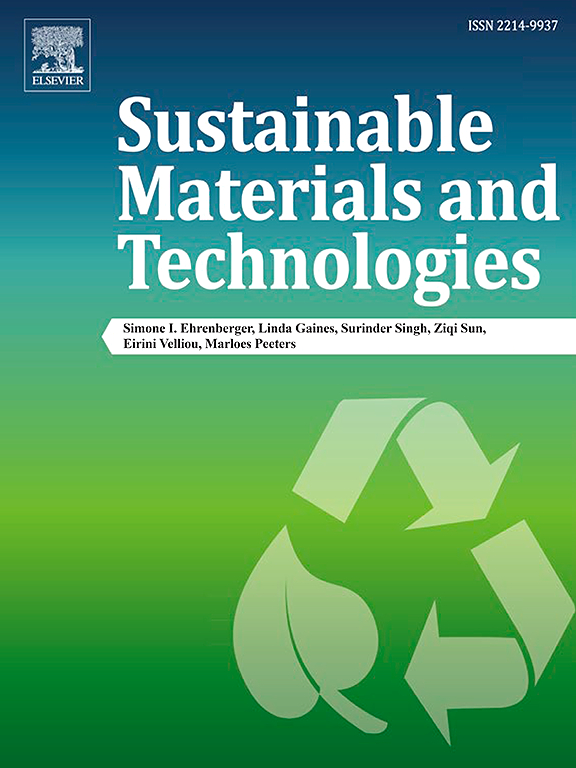Geopolymer-based composite and hybrid materials: The synergistic interaction between components
IF 8.6
2区 工程技术
Q1 ENERGY & FUELS
引用次数: 0
Abstract
In recent years, there has been a growing drive toward developing innovative materials capable of meeting the demands of sustainability, durability, and high performance across multiple application sectors. In this context, geopolymer-based composites and hybrid materials have emerged as highly promising candidates, leveraging the synergistic interactions between inorganic geopolymer matrices and reinforcing phases of diverse nature, ranging from fibers and nanoparticles to organic polymers and industrial waste derivatives. These combinations enable the fine-tuning of mechanical, thermal, and chemical properties, creating materials tailored for specific functional and structural roles. Recent research on geopolymer-based composites has shown that the integration of reinforcements not only improves crack resistance and toughness but also expands the range of applications beyond traditional construction. Moreover, the development of true hybrid systems, especially through co-reticulation or cross-linking with organic polymers, has paved the way for materials with enhanced interfacial bonding, multifunctionality, and superior performance. Despite significant progress in the field, a comprehensive, comparative overview that critically examines the relationships between synthesis strategies, interfacial chemistry, structure-property correlations, and application potentials of these materials remains lacking. This review aims to fill that gap by offering an in-depth exploration of geopolymer-based composites and hybrids, focusing particularly on the chemistry of interactions at the organic–inorganic interface, the mechanisms underpinning performance enhancement, and the emerging uses of these systems in advanced domains such as catalysis, pollutant adsorption, energy storage, and fire-resistant insulation. The paper highlights the versatility of geopolymers as a sustainable platform for next-generation functional materials, while also identifying current limitations and outlining key directions for future research and industrial scalability.
地聚合物基复合材料和杂化材料:组分之间的协同作用
近年来,越来越多的人致力于开发创新材料,以满足多个应用领域对可持续性、耐用性和高性能的需求。在这种背景下,地聚合物基复合材料和杂化材料已经成为极有前途的候选材料,利用无机地聚合物基质和不同性质的增强相之间的协同作用,从纤维和纳米颗粒到有机聚合物和工业废物衍生物。这些组合可以对机械、热学和化学性能进行微调,创造出适合特定功能和结构角色的材料。最近对地聚合物基复合材料的研究表明,增强剂的集成不仅提高了抗裂性和韧性,而且扩大了传统建筑以外的应用范围。此外,真正的混合体系的发展,特别是通过与有机聚合物的共网状或交联,为具有增强界面键合,多功能性和卓越性能的材料铺平了道路。尽管在该领域取得了重大进展,但对这些材料的合成策略、界面化学、结构-性质相关性和应用潜力之间的关系进行批判性研究的全面、比较综述仍然缺乏。这篇综述旨在通过深入探索地聚合物基复合材料和杂化材料来填补这一空白,特别关注有机-无机界面相互作用的化学性质,增强性能的机制,以及这些系统在催化、污染物吸附、储能和耐火绝缘等先进领域的新应用。该论文强调了地聚合物作为下一代功能材料可持续发展平台的多功能性,同时也指出了当前的局限性,并概述了未来研究和工业可扩展性的关键方向。
本文章由计算机程序翻译,如有差异,请以英文原文为准。
求助全文
约1分钟内获得全文
求助全文
来源期刊

Sustainable Materials and Technologies
Energy-Renewable Energy, Sustainability and the Environment
CiteScore
13.40
自引率
4.20%
发文量
158
审稿时长
45 days
期刊介绍:
Sustainable Materials and Technologies (SM&T), an international, cross-disciplinary, fully open access journal published by Elsevier, focuses on original full-length research articles and reviews. It covers applied or fundamental science of nano-, micro-, meso-, and macro-scale aspects of materials and technologies for sustainable development. SM&T gives special attention to contributions that bridge the knowledge gap between materials and system designs.
 求助内容:
求助内容: 应助结果提醒方式:
应助结果提醒方式:


